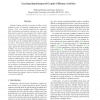Free Online Productivity Tools
i2Speak
i2Symbol
i2OCR
iTex2Img
iWeb2Print
iWeb2Shot
i2Type
iPdf2Split
iPdf2Merge
i2Bopomofo
i2Arabic
i2Style
i2Image
i2PDF
iLatex2Rtf
Sci2ools
ICCV
2011
IEEE
2011
IEEE
Learning Spatiotemporal Graphs of Human Activities
Complex human activities occurring in videos can be defined in terms of temporal configurations of primitive actions. Prior work typically hand-picks the primitives, their total number, and temporal relations (e.g., allow only followed-by), and then only estimates their relative significance for activity recognition. We advance prior work by learning what activity parts and their spatiotemporal relations should be captured to represent the activity, and how relevant they are for enabling efficient inference in realistic videos. We represent videos by spatiotemporal graphs, where nodes correspond to multiscale video segments, and edges capture their hierarchical, temporal, and spatial relationships. Access to video segments is provided by our new, multiscale segmenter. Given a set of training spatiotemporal graphs, we learn their archetype graph, and pdf’s associated with model nodes and edges. The model adaptively learns from data relevant video segments and their relations, addr...
| Added | 11 Dec 2011 |
| Updated | 11 Dec 2011 |
| Type | Journal |
| Year | 2011 |
| Where | ICCV |
| Authors | William Brendel, Sinisa Todorovic |
Comments (0)

